
CompuPro - RAM Boards
Godbout Electronics - CompuPro sold more
types of RAM boards than anybody else in the S-100 Business. All their boards
were static RAM cards. Bill Godbout felt that the reliability and flexibility of
static RAM chips exceeded the advantages of the lower priced dynamic memory
chips. This was certainly true in the early days when dynamic RAM S-100 boards
did not have onboard memory refresh controllers and were sensitive to long reset
pulses or DMA states. As the bus evolves into the use of multiprocessor systems
static RAM boards also were easier to interface on the bus.
Because of the sheer number of CompuPro
RAM boards I will bunch them all together on this one page. In very general
terms (particularly the earlier boards) they were electronically similar, "clean"
and simple. I am missing some good pictures for some. If you have any I
will place them here for others to see.
ECONORAM
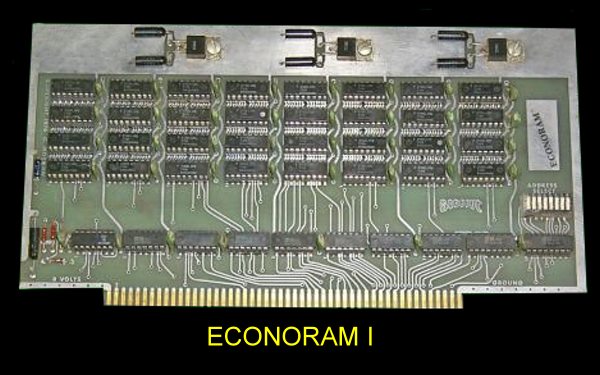
The EconoRAM was Godbout's
first RAM board. Memory could occupy any of 16K blocks and any 4K block
within that 16K. Memory consisted of 32 2102's
ECONORAM II
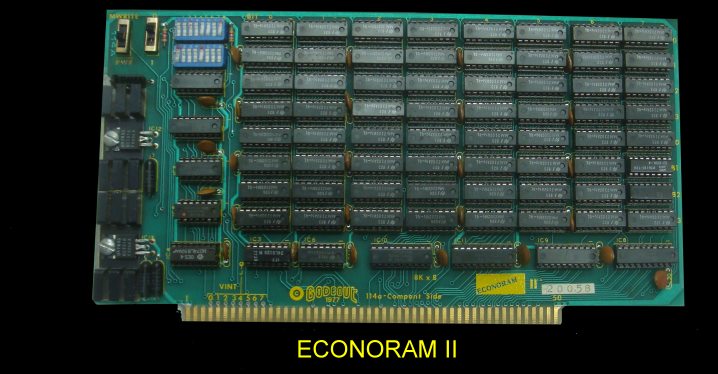
This board had the
ability to trigger an interrupt if an attempt was made to write to a
protected area on the board. The board could be addressed in any one of
4 16K blocks and then any 4K within that block.
The manual for the board is
here.
ECONORAM IV

This 16K static RAM board utilized TMS
40L44 or MM5257 RAM chips and ran at 4MHz without any wait states. Memory
chips were grouped into a single 16K memory block. The board was addressable on
any 16K boundary. Each 4K segment could b e write protected. The switch S2
allowed the S-100 MWRITE signal to be generated on the board.
The manual for this board can be
obtained here.
ECONORAM XIV
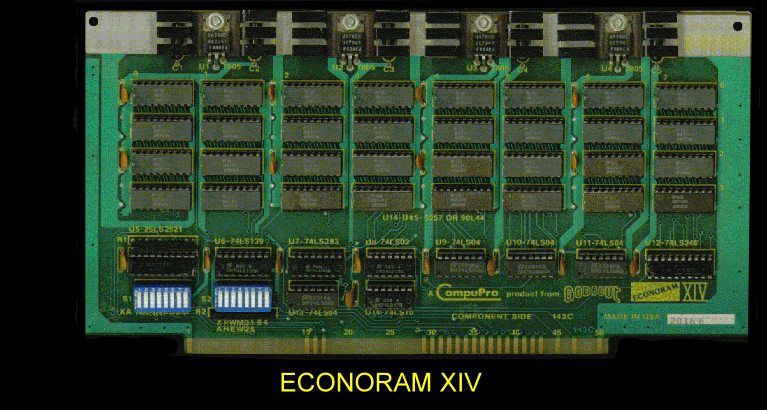
This is an IEEE-696 16K Static RAM memory board. It had 24 Bit Addresssing
and also used MM5257/90L44 Static RAM chips
The manual for this board can be seen
here.
CompuPro RAM16
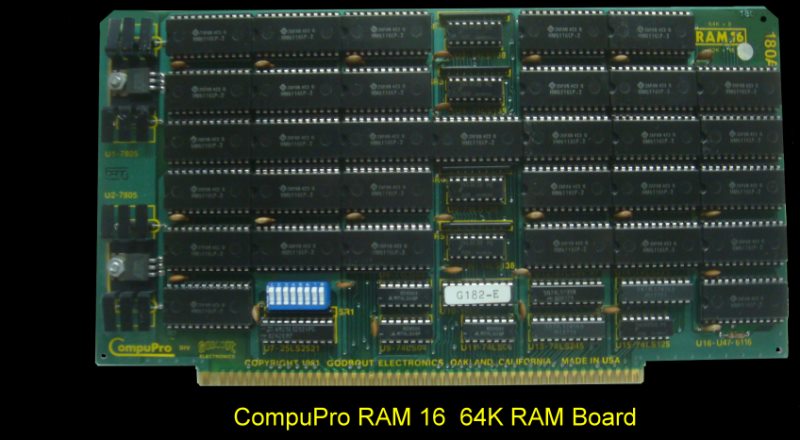
The RAM-16 uses thirty-two of the 6116
CMOS RAM chips to provide a total of 64K bytes or 32K words of storage. The
RAM-16 was addressable on any 64K byte boundary in the 16 megabyte address space
as specified by the IEEE 696 standard. The RAM-16 also dynamically switched
between "byte-wide" or "word-wide" modes per the state of the sXTRQ* signal on
the S-100 Bus. The board was designed to work with 8036/88 type processors at
speeds exceeding 10 MHz. It also handled DMA flawlessly, a feature few
dynamic 64K RAM boards can really do. To reduce the number of support ICs
required to pack all these function and capacity onto a standard height S-100
board, a PAL (programmable-array-logic) element was used. The PAL selects the
proper memory chip or chips and controls the complicated data bus switching
scheme required to mix 8 and 16 bit operations.
The manual for this board can be
obtained
here.
Bill Machrone compared this board to some others in an
article in the January 1983 issue of Microsystems (Vol 4, #1, p70). It can
be seen
here.
CompuPro RAM 17
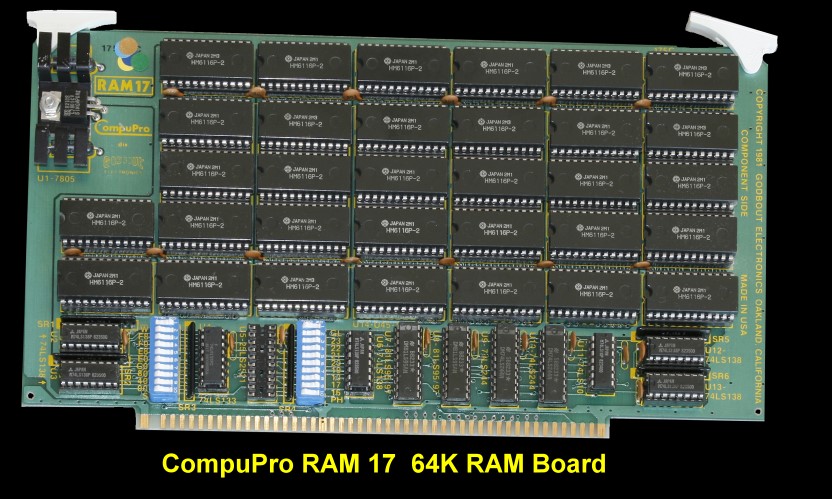
The RAM-17 was a 64K static RAM board
designed especially for multiuser systems where speed, density, reliability and
low-power were at a premium. Using Hitachi 6116 CMOS "byte-wide" 16K RAM's, the
RAM-17 could be configured as an Extended Address board (compatible with the
8088 CPU or with Godbout memory management hardware), or as Global memory - When
used in conjunction with a Compupro CPU or Memory Manager board, the RAM 17 can
be treated in software as a conventional Bank Select board .
The RAM-17 was configured as a single
64K block beginning at any 64K address within the entire 24 bit (16 Megabyte)
address range specified for the S-100 bus by IEEE spec 696. Four 16K segments
may be individually disabled through an on-board DIP switch, and the highest 8K
block (E000H-FFFFH) is further divided into four 2K blocks which may also be
individually switch disabled. This allowed the use of the RAM-17 with a broad
selection of memory mapped devices such as disk controllers and video boards.
This "windowing" ability also allowed a multi-user system to have a single
"Global" board plus a number of partially populated RAM-17's (e.g., one for each
user). The RAM-17 was shipped as a 48K or 64K board. Partially populated
boards could be upgraded simply by inserting additional 6116 RAM IC"s into the
pre-installed DIP sockets (all boards came with all 32 RAM IC sockets wave
soldered in place). Extra heavy duty power traces, generous bypassing of
supply lines, sockets for all integrated circuits, careful layout, innovative
design conservatively implemented, premium parts, and a double sided,
solder-masked printed circuit board with complete component legends made this a
versatile, dependable, high performance memory board.
Since RAM memory was one of the most
expensive components in any S-100 installation, using the RAM 17 as the heart of
a system insured that the transition to faster CPU"s and/or more sophisticated
memory management software would be as easy and inexpensive as possible. Because
of the board's extremely low power consumption (populated to 64K, these boards
draw less than 200 milliamps), numerous RAM-17's could be combined without
exceeding the capacity of the system power supply. Because of the boar's high
density, large amounts of RAM (up to a megabyte) could be configured in a single
system without running out of card slots. Since the board was guaranteed
to run with 6 MHz Z-80"s and 10 MHz 8086/88"s, upgrading to faster CPU"s did not
threaten your investment in memory.
The manual for this board can be
obtained here.
Bill Machrone compared this board to some others in an
article in the January 1983 issue of Microsystems (Vol 4, #1, p70). It can
be seen
here.
CompuPro RAM 20
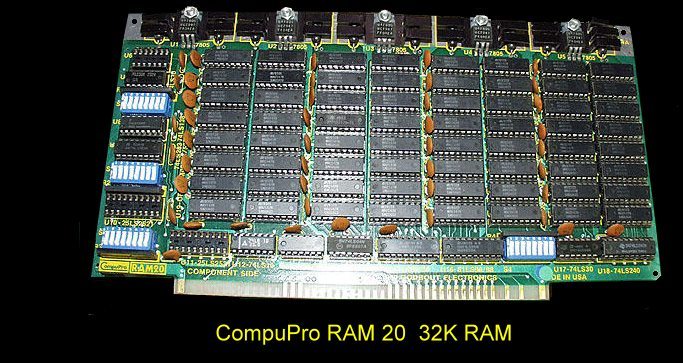
The RAM-20 was a high speed (10 MHz),
low power (about 1.5 Amps on 8V), 32K byte static RAM board designed to conform
to IEEE spec 696 for the S-100 bus. The RAM-20 could be configured as a
conventional Bank Select board (compatible with Cromemco and North Star etc.
Bank Select schemes), as an Extended Address board (compatible with the 8088 CPU
or with CompuPro memory management hardware), or as a Global memory board. The
board was addressable as a single 32K block which may begin at any 4K address
within a 64K page. Within that selected 64K page, the board addressing would, if
necessary, 'wrap around' from the top of RAM to the bottom. Also within the 64K
page, up to 8 4K 'windows', or unoccupied address spaces, may be created
manually through an 8 paddle DIP switch provided for this purpose. The
RAM-20 was shipped as a 16K, 24K, or a full 32K board. Partially populated
boards may be upgraded simply by inserting additional 5257/2147 type RAM IC's
into pre-installed DIP sockets (all boards came with all 64 RAM IC sockets wave
soldered in place.) Extra heavy duty power traces, generous bypassing of supply
lines, sockets for all integrated circuits, careful layout, innovative design
conservatively implemented, premium parts, and a double sided, solder-masked
printed circuit board with complete component legends made this a versatile,
dependable, high performance memory board. Since dense memory were among the
most costly items in any S-100 installation, using the RAM-20 as the heart of a
system insured that the transition to faster CPU's and/or more sophisticated
memory management software would be as easy and inexpensive. Because of the
board's extremely low power consumption, numerous RAM-20's could be combined
without over heating the system or exceeding the capacity of the system power
supply.
The manual for this board can be
obtained here.
CompuPro RAM 21
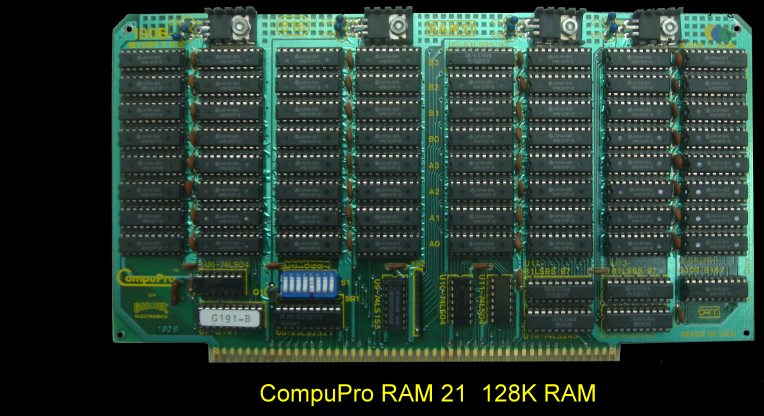
The RAM-21 uses sixty-four high
performance 16K X 1 MOS RAM chips to provide a total of 128K bytes or 64K words
of storage. The RAM- 21 was addressable on any 128K byte boundary in the 16
megabyte address space specified by the IEEE 696 standard. The RAM-21 also
dynamically switched between "byte-wide" or "word-wide" modes per the state of
the sXTRQ* signal on the S-100 Bus. The board was designed to work with
8086/88 type processors at speeds exceeding 10 MHz. It also handles DMA
flawlessly, a feature few boards could do at those speeds. To reduce the number
of support ICs required to pack all this functionality and capacity onto a
standard height S-100 board, a PAL (programmable-array-logic) element is
used. The PAL selects the proper memory chips and controls the complicated data
bus switching scheme required to mix 8 and 16 bit operations.
The manual for this board can be
obtained
here.
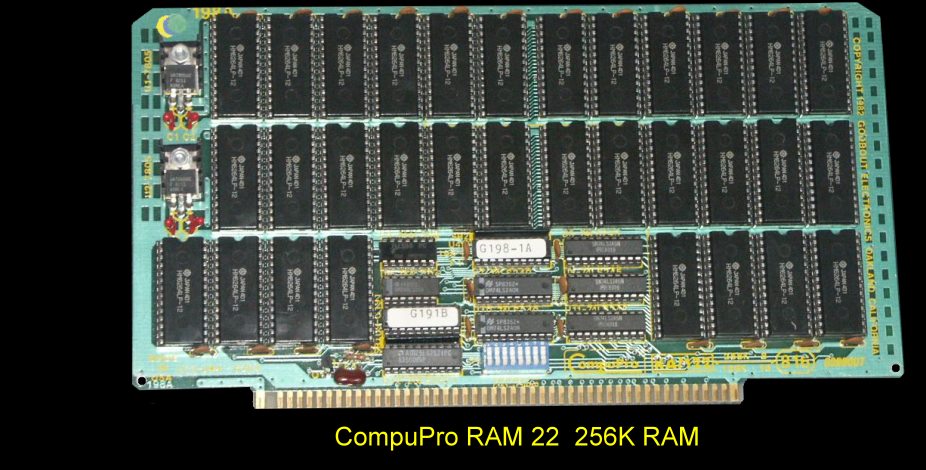
The RAM-22 used thirty-two high
performance 8K X 8 CMOS RAM chips to provide a total of 256K bytes or 128K words
of storage. The RAM- 22 was addressable on any 256K byte boundary in the 16
megabyte address space specified by the IEEE 696 standard. The RAM 22
also dynamically switched between "byte-wide" or "word-wide" modes per the state
of the sXTRQ* signal on the S-100 Bus. The board was designed to work with
8086/88 type processors at speeds exceeding 10 MHz. It also handles DMA
flawlessly at these speeds. To reduce the number of support ICs required to pack
all this function and capacity onto a standard height S-100 board, two PAL
(programmable-array-logic) elements are used- The PAL selects the proper memory
chips and controls the complicated data bus switching scheme required to mix 8
and 16 bit operations.
The manual for this board can be
obtained here.
CompuPro RAM 24
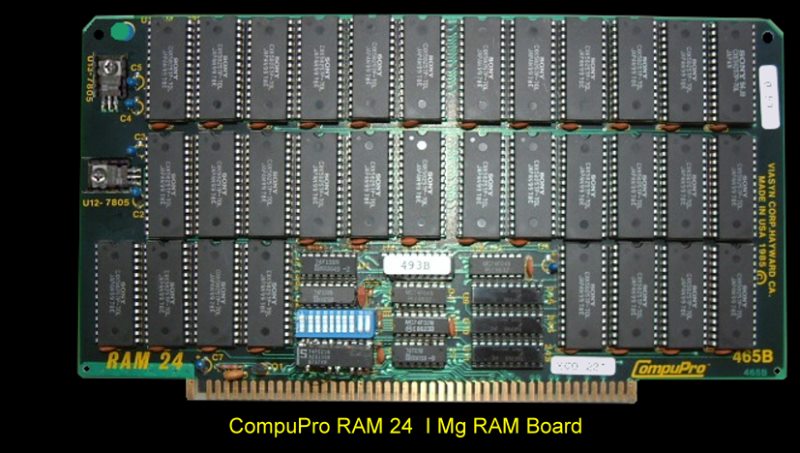
The RAM-24 was the final and top of the
line CompuPro RAM board. It represents one of the most advanced RAM boards ever
produced for the IEEE 696/S-100 Bus. By combining state-of-the-art static CMOS
RAM technology with CompuPro's design excellence, the RAM-24 offered the a very
versatile, efficient and reliable board. The board worked as "word-wide" memory
for 16-bit systems and automatically switches to "byte-wide" mode in 8-bit
systems. The RAM-24 uses 32 high performance 32K X 8 CMOS RAM chips to provide a
total of 1 megabyte or 512K words of storage. The RAM-24 was addressable on any
1 megabyte boundary in the 16 megabyte address space specified by the IEEE 696
standard. The basic RAM-24 board could be configured by CompuPro to accept 512
Kbytes, 768 Kbytes or 1 megabyte of RAM. In addition, it could be configured by
CompuPro to have the lower 256K of its memory set as global memory, that is, the
lower 256K appears in all sixteen 1 Mbyte spaces of the 16 Mbyte S-100 address
space. CompuPro's RAM-24 has plenty of speed to run with their 80286 CPU board,
68000 CPU board, or their 8085/88 CPU board all at their highest speeds.
The manual for the board can be obtained
here.
This page was last modified
on
09/27/2011











